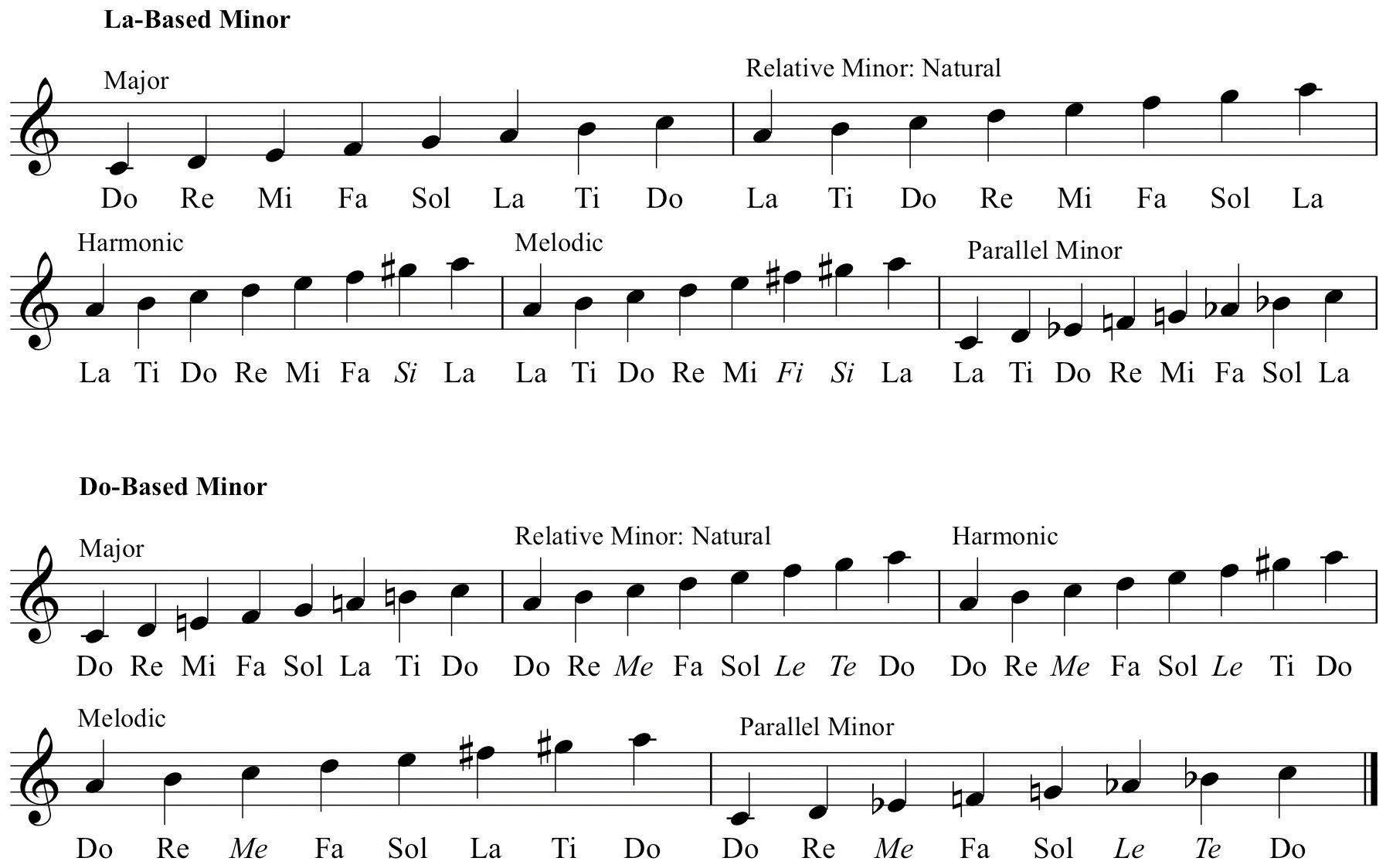This is “Solfége Revisited”, section 3.3 from the book Music Theory (v. 1.0). For details on it (including licensing), click here.
For more information on the source of this book, or why it is available for free, please see the project's home page. You can browse or download additional books there. To download a .zip file containing this book to use offline, simply click here.
3.3 Solfége Revisited
Learning Objectives
- Solfége systems: a comparison.
- The audio-acoustic “trigger.”
In Chapter 2 "The Elements of Pitch:Sound, Symbol, and Tone", solfége was explained in its historical and pedagogical context, and as one way of labeling pitch and as a mnemonic device. The principal use of solfége as a pedagogical tool is the aural reinforcement of written music.
Many differing solfége systems have evolved, each for a specific reason, for a specific context, or to offer an alternate method to a previous system. They can be classified into two broad categories:
- Fixed DoA solfége system wherein Do is always C, Re is always D, and so forth.: Do is always sung as some form of the pitch name “C.” All other pitches are labeled accordingly.
- Moveable DoA solfége system wherein Do shifts to the starting pitch of the scale. Other syllables are sung in relationship to this.: Do will shift to whatever pitch serves as the Tonic. All other pitches shift accordingly.
Several subcategories have evolved from Moveable-Do and involve the treatment of the Minor mode. The two most prevalent are called La-based MinorA sub-category of Moveable Do. Major is sung beginning on Do, Minor begins on La. and Do-based MinorA sub-category of Moveable Do. Both Major and Minor begin on Do..
-
La-based Minor: The Tonic in Major begins on Do. The Tonic in Minor begins on La.
General advantages:
- Ease of use from a melodic orientation in predominantly diatonic music.
- Half step placement is retained between Major and Relative Minor (Mi-Fa, Ti-Do).
- Widely used as a part of Orff-Kódaly training.
Minor syllables in La-based Minor:
ˆ ˆ ˆ ˆ ˆ ˆ ˆ ˆ 1 2 3 4 5 6 7 8 Natural Minor: La Ti Do Re Mi Fa Ti Do Harmonic Minor: La Ti Do Re Mi Fa Si La (Raised 7: Si) Melodic Minor: La Ti Do Re Mi Fa Si La (Raised 6 and 7: Fi-Si) -
Do-based Minor: The Tonic in both Major and Minor begin on Do.
General advantages:
- More adaptable when chromaticism in encountered.
- Has greater harmonic consequence pedagogically for the average student.
- In use to a greater degree in Music Theory curricula.
Minor syllables in Do-based Minor :
ˆ ˆ ˆ ˆ ˆ ˆ ˆ ˆ 1 2 3 4 5 6 7 8 Natural Minor: Do Re Mi Fa Sol Le Te Do (Me, Le, Te pronounced “may,” “lay,” “tay”) Harmonic Minor: Do Re Mi Fa Sol Le Ti Do (Raised 7: Ti) Melodic Minor: Do Re Mi Fa Sol La Ti Do (Raised 6 and 7: La-Ti)
Each system has its advocates and its detractors. Each has perceived advantages and disadvantages. Having used all known systems, the author has had the greatest student success employing the Do-based model. After an initial familiarization period (because of the use of altered syllables), the vast majority of typical undergraduate music theory students respond to this system.
Figure 3.15 La-based and Do-based compared

Regardless of which solmization system is used, the purpose remains the same. After a period of familiarization and rote drill, the student will begin to recognize patterns aurally. This is to say that recognition will not merely be aural recognition when heard, but rather, specific patterns will be “engraved” in the student’s mind. These patterns will be solfége-triggered responses. This audio-acoustic trigger response will increase and become more fluent with practice.
Key Takeaways
The student should understand:
- Fixed-Do as opposed to Moveable Do.
- La-based as opposed to Do-based systems.
Exercises
- In a comfortable register, practice singing a Major scale using syllables, ascending and descending. Gradually increase your tempo.
- From your Do, sing down, “Do-Ti-La.” Now sing the Natural Minor scale in La-based Minor, ascending and descending. Increase your tempo.
- Next, sing the same Natural Minor scale, but use Do–based Minor syllables.
- As an audio-acoustic exercise, think of the patterns, Ti-Do, Do-Re-Do, Do-Mi-Sol, Do-Mi-Sol-Mi-Do-Sol-Do, Sol-Ti-Re-Ti-Sol-Do. Sing what you hear. Confirm at the piano.




